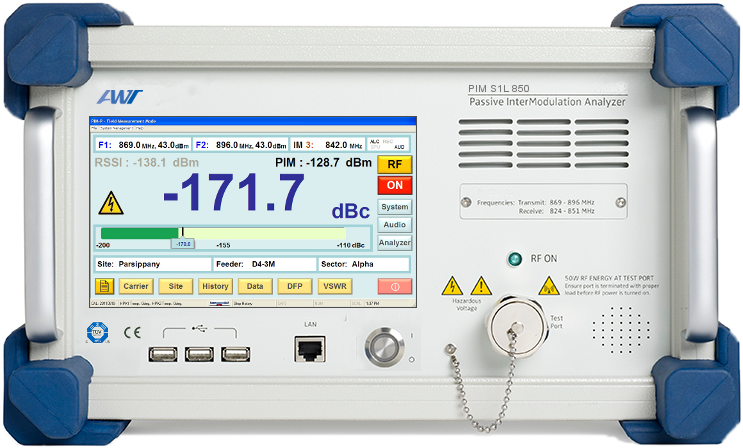AWT’s S1L Series PIM analyzers are fully conform to PIM standard IEC62037. These PIM testers have a very low noise floor, are very sensitive and come with a wealth of other features. PS1L analyzers are the ideal PIM test equipment choice for laboratory and QA.

Data Sheet Sales Offices eContact us
Features
-
Test Modes: Diagnostic, Analyzer with Graphs, Sweep Mode (option), Distance to PIM (option), Distance to Fault (option).
-
Very high PIM sensitivity: -172 dBc @ 2x 43 dBm carriers.
-
Output power variable from 15dBm to 44dBm.
-
Measures intermodulation products IM3, IM5 IM7, IM9, IM11 up to IM25
-
PIM over Time Graph and Sweep Mode
-
Maxhold feature
-
Data recording: CSV, PDF, Screenshot (BMP)
High quality, low PIM components are particularly important to achieve maximal network capacity. Signal degradation affects operator’s revenue streams due to reduced data capacity. Leading global manufacturers use AWT Global PIM analyzers to guarantee lowest PIM values of of their wireless components and products.
Passive Intermodulation – PIM
Passive Intermodulation (PIM) is an unwanted mixing effect caused by non-linearity of passive components in the RF path of telecommunication systems. PIM diverts signal energy to other frequencies (spurious signals). This can generate interfering signals that may fall into receiving bands causing serious degradation of system performance.
Causes of PIM
-
Dissimilar metals with different electrical properties as well as corroded components and structures.
-
Ferromagnetic metals like iron, nickel and steel, show hysteresis effects when RF energy is applied.
-
Irregular contact areas, even on a microscopic scale, cause an inconsistent flow of electrons, generating inhomogeneous electrical fields.
-
Spark discharges that may happen by accidental “hot” connections and disconnections create craters on the connectors’ surfaces and lead to chemical reactions
RF Components that may cause PIM
-
Cables
-
Connectors
-
Antennas
-
Attenuators, Loads
-
Filters, Diplexers, Duplexers
-
Combiners, Splitters, Couplers
-
Tappers, Surge Protectors
Order Number
|
Technologies / Type
|
Tx Frequency (MHz)
|
Rx Frequency (MHz)
|
|
PS1L700U |
LTE700 / 700 MHz Upper Band |
730 ~ 759 |
776 ~ 788 |
|
PS1L700L |
LTE700 / 700 MHz Lower band |
728 ~ 759 |
698 ~ 716 |
|
PS1L700APT |
APT700 / Asia Pacific Telecommunity / 3GPP-28 |
758 ~ 803 |
703 ~ 748 |
|
PS1L800 |
LTE800 |
791 ~ 821 |
832 ~ 862 |
|
PS1L800SMR |
SMR800 |
851 ~ 869 |
806 ~ 824 |
|
PS1L850 |
CDMA850 / 850 MHz |
869 ~ 896 |
824 ~ 851 |
|
PS1L900 |
GSM900 / 900 MHz |
935 ~ 960 |
890 ~ 915 |
|
PS1L900E |
EGSM900 |
925 ~ 960 |
880 ~ 915 |
|
PS1L1500 |
LTE-1500 Japan / 1500 MHz |
1488 ~ 1520 |
1456 ~ 1480 |
|
PS1L1800 |
GSM 1800 / DCS 1800 / 1800 MHz |
1805 ~ 1880 |
1710 ~ 1785 |
|
PS1L1900 |
PCS 1900 / 1900 MHz |
1930 ~ 1990 |
1850 ~ 1910 |
|
PS1L1921PA |
PCS 1900/ 1900 MHz
AWS / 2100 MHz
(Tx signal bands can be mixed) |
1930 ~ 1935
2110 ~ 2155 |
1850 ~ 1910
1710 ~ 1755 |
|
PS1L2100AWS |
AWS |
2110 ~ 2155 |
1710 ~ 1755 |
|
PS1L2000TD |
TD-SCDMA(2000) |
2010 ~ 2025 |
1900 ~ 1920 |
|
PS1L2100UMTS |
UMTS/W-CDMA / 2100 MHz |
2110 ~ 2170 |
1920 ~ 1980 |
|
PS1L2160JP |
W-CDMA-JP |
2150 ~ 2170 |
2110 ~ 2140 |
|
PS1L2600LTE |
IMT-E(2600) / LTE 2600 / 2600 MHz |
2620 ~ 2690 |
2500 ~ 2570 |
Accessories
|
|
POPT1 |
VSWR / DTP (Distance to PIM) Option |
|
PACC2 |
Accessory Kit: low PIM cables 3m / 10ft low PIM load 50W / 10W, adapters, torque wrench with hard carry case. |
|
PLOAD100 |
Low PIM Load: 100W, PIM <-165dBc @ 2x 43dBm, Frequency: 690 – 2800 MHz, Connector: DIN(f) |
|
PLOAD50 |
Low PIM Load: 50/10W, PIM <-165dBc @ 2x 43dBm, Frequency: 690 – 2800 MHz, 2 Connectors: DIN(f) – DIN(m) |
|
ADA-DMDF |
Connector Saver. Adapter DIN(m)-DIN(f), PIM <-165dBc @ 2x43dBm, protects ports of PIM analyzers and loads. |
|
LIC308-DMDM-1M |
Low PIM cable 1m (3ft), PIM <-165dBc @ 2x43dBm, DIN(m)-DIN(m), extra long metal sleeve for long lasting performance. |
|
LIC308-DMDM-2M |
Low PIM cable 2m (6ft), PIM <-165dBc @ 2x43dBm, DIN(m)-DIN(m), extra long metal sleeve for long lasting performance. |